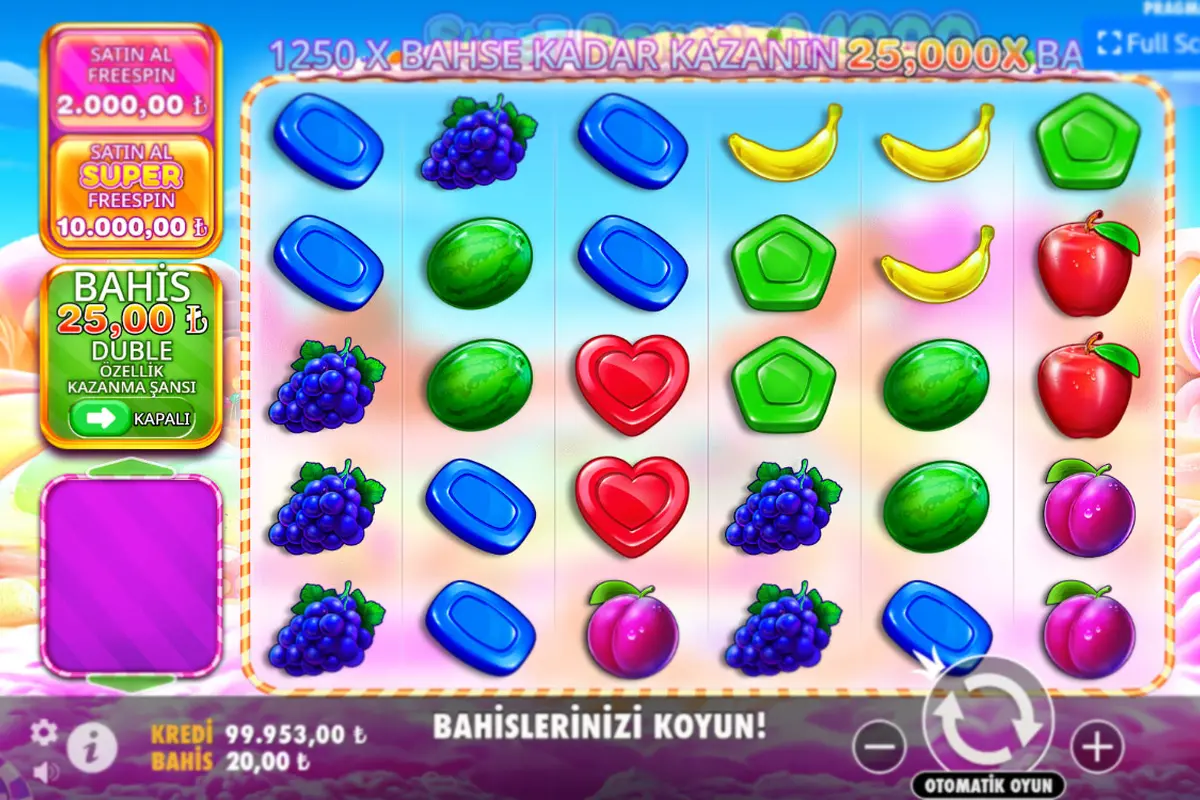Sweet Bonanza 1000: Türkiye'de En Yüksek
Sweet Bonanza 1000: Pragmatic Play'in Eğlenceli Dünyası
Sweet Bonanza 1000, Pragmatic Play tarafından geliştirilen heyecan verici bir online slot oyunudur. Bu oyun, renkli ve neşeli bir temaya sahip olup, oyuncuları şekerlerin ve meyvelerin dolu olduğu bir dünyaya götürmektedir. Oyun, kullanıcılarına yüksek geri dönüş oranları sunmasıyla dikkat çekiyor. Ayrıca, oyun içindeki çeşitli bonus özellikleri ve çarpanlar, oyuncuların kazanma şansını artırmaktadır. Demosu ile oyuncular, gerçek parayla oynamadan önce oyunun dinamiklerini keşfedebilirler.
Sweet Bonanza 1000'de, oyuncular farklı sembollerin bir araya gelmesiyle büyük kazançlar elde edebilirler. Bu slot oyununu oynamak için herhangi bir ön bilgi gerekmemektedir. Her yaştan oyuncuya hitap eden bu oyun, kullanım kolaylığı ve eğlenceli yapısıyla herkesin beğenisini kazanıyor. Oyunu denemek isteyenler, APK dosyasını indirerek mobil cihazlarında da keyifle oynayabilirler. Hem telefonda hem de tablette sorunsuz bir şekilde çalışması, oyunun erişilebilirliğini artırmaktadır.
| 🎮 Oyun Adı | Sweet Bonanza 1000 |
| 🎉 Geliştirici | Pragmatic Play |
| 💰 RTP | %96.51 |
| 💎 Minimum Bahis | 0,20 |
| 🏆 Maksimum Bahis | 100 |
| 🍭 Kazanma Yolu | Çarpanlar ve Free Spin |
| 🌀 Varyans | Yüksek |
| 📱 Mobil Uyumluluk | Evet |
| 💫 Özellikler | Bonus Çarkı, Free Spins, Çarpanlar |
| 🌟 Semboller | Meyve, Şeker, Kalp |
| ⚡ Oyun Türü | Slot Oyunu |
| 📅 Çıkış Tarihi | 2021 |
| 🎉 Max Kazanımlar | 5000x Bahis |
| 🔒 Lisans | Malta Oyun Otoritesi |
| 🆓 Demosu | Evet |
Mobil Versiyon: Sweet Bonanza 1000
Sweet Bonanza 1000'in mobil versiyonu, oyunculara her zaman ve her yerde oyun deneyimi sunmaktadır. Mobil cihazlara uygun olarak tasarlanan bu oyun, kullanıcı dostu arayüzü sayesinde kolayca oynanabilir. Sweet Bonanza 1000'in APK dosyasını indirerek, telefonunuzda veya tabletinizde kesintisiz bir oyun deneyimi yaşayabilirsiniz. Mobil versiyon, grafik kalitesi ve oyun akışı açısından masaüstü versiyonu kadar etkileyicidir.
Ayrıca, mobil sürümde de aynı heyecan verici özellikler ve kazanma şansları bulunmaktadır. Oyuncular, oyun içindeki bonusları ve çarpanları aktif bir şekilde kullanarak büyük kazançlar elde etme fırsatına sahip olurlar. Uygulamanın hafif yapısı sayesinde, cihazınızda fazla yer kaplamadan keyifle oynayabilirsiniz. İster evde ister dışarıda olun, Sweet Bonanza 1000 her an sizinle!
Artılar ve Eksiler
Artılar
- Yüksek geri dönüş oranı
- Renkli ve eğlenceli grafikler
- Mobil uyumluluk
- Çeşitli bonus ve çarpan özellikleri
- Demoversion ile deneme imkanı
Eksiler
- Yüksek varyans, yüksek risk
- Maksimum kazanım sınırlı
- Gerçek para ile oynarken kaybetme riski
- Bazı bonuslar için şans faktörü gereklidir
- Oyun süresi sınırlı olabilir

Pragmatic Play Hakkında
Pragmatic Play, çevrim içi casino dünyasında sektörün lider oyun sağlayıcılarından biri olarak öne çıkar. Yaratıcılığı ve inovatif yaklaşımıyla tanınan Pragmatic Play, çeşitli temalar ve gelişmiş özelliklerle dolu slotlar, canlı casino oyunları ve masa oyunları geliştirir. Sweet Bonanza 1000 gibi popüler yapımların yanı sıra, Sugar Rush, Big Bass Bonanza – Reel Action ve Revenge of Loki Megaways™ gibi başarılı slot oyunları da portföyünde bulunur. Firma, her zaman oyunculara yeni deneyimler sunmayı hedefler ve yüksek kazanç potansiyelli oyunlarla adından söz ettirir.
Sweet Bonanza 1000’de Bonuslar ve Free Spins
Sweet Bonanza 1000, oyunculara rengarenk bir şeker diyarında yüksek kazanç fırsatları sunan eşsiz slot oyunudur. Oyunda bonus ve free spins (ücretsiz döndürme) özellikleri, kazançları katlama şansı ile öne çıkar:
- En az dört adet lolipop Scatter sembolü yakalandığında 10 adet ücretsiz döndürme başlatılır.
- Free spins turu sırasında üç veya daha fazla Scatter sembolü gelirse, her seferinde 5 ek ücretsiz döndürme kazanılır.
- Bonus turunda ekrana gelen şeker bombası çarpanları, her biri rastgele değere sahip olarak bahsin 1.000 katına kadar çıkabilir.
- Tumble (takla) özelliği ile arka arkaya gelen kazançlarda tüm çarpanlar toplanır ve toplam kazanca uygulanır.
- Oyunda maksimum kazanç potansiyeli, bahsin 25.000 katına kadar ulaşabilir.
Sweet Bonanza 1000 ile Casino Kaydı ve Gerçek Parayla Oyun
Sweet Bonanza 1000 gibi popüler slot oyunlarında gerçek parayla oynamak için öncelikle bir çevrim içi casino sitesine kayıt olmak gerekir. Kayıt işlemi genellikle birkaç temel adımdan oluşur: kişisel bilgilerinizi doldurur, e-posta adresinizi onaylarsınız ve hesabınıza güvenli bir şekilde para yatırırsınız. Hesabınız hazır olduğunda, Sweet Bonanza 1000 oyununu bulup gerçek parayla oynamaya başlayabilirsiniz. Böylece ücretsiz demoların ötesine geçerek, oyunun sunduğu büyük çarpanlar ve ödüllerle heyecan dolu bir deneyim yaşayabilirsiniz.

Sweet Bonanza 1000 Hakkında Sıkça Sorulan Sorular
Sweet Bonanza 1000 nedir?
Sweet Bonanza 1000, Pragmatic Play'in popüler şeker temalı slot oyunu Sweet Bonanza'nın geliştirilmiş bir versiyonudur. Bu oyun, klasik sürümün eğlencesini korur ve çarpan, free spin gibi özellikleri daha yüksek kazanç potansiyeli ile sunar.
Sweet Bonanza 1000'de en yüksek kazanç ne kadar olabilir?
Oyunda bir spinde elde edilebilecek maksimum kazanç, oyuncunun bahis tutarının tam 25.000 katıdır. Özellikle bonus oyunlarında büyük çarpanlarla bu yüksek kazançlar daha ulaşılabilir hale gelir.
Free spin özelliği nasıl çalışır?
Dört veya daha fazla Scatter (lolipop) sembolü geldiğinde, oyuncu 10 ücretsiz döndürme kazanır. Bonus oyunda ise ek Scatter sembolleri ile fazladan free spinler alabilirsiniz. Tüm çarpanlar, tumble özelliğiyle elde edilen toplam kazanca eklenir.
Sweet Bonanza 1000 hangi çarpanları sunar?
Bonus oyununda çarpanlar, bahsin 1.000 katına kadar rastgele bir değer alabilir. Bu çarpanlar, tumble özelliğinden elde edilen toplam kazanca eklenerek büyük ödemeler sağlayabilir.
Oyunun oynanış mekanikleri nelerdir?
Sweet Bonanza 1000'de klasik makara sistemi yoktur. En az 8 aynı türde sembol ekranda geldiğinde kazanç elde edilir. Kazançlı semboller yok olur ve yerlerine yenileri düşer (tumble), bu da ek kazanç fırsatlarının oluşmasını sağlar.
Sweet Bonanza 1000’in RTP’si (Oyuncuya Dönüş Oranı) nedir?
Oyunun RTP (teorik oyuncuya dönüş oranı) yaklaşık %95.50 civarındadır. Yani uzun vadede oyuncular yatırımlarının bu oranındaki bir kısmını geri almayı bekleyebilirler.
Sweet Bonanza 1000’i mobil cihazlarda oynayabilir miyim?
Evet, Sweet Bonanza 1000 hem masaüstü hem de mobil cihazlarda sorunsuz biçimde çalışacak şekilde tasarlanmıştır. İster telefondan ister tabletten kolayca oynayabilirsiniz.
